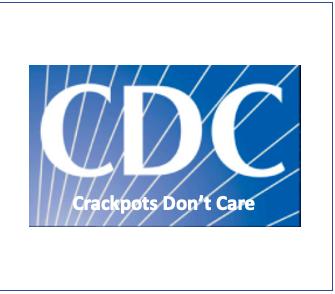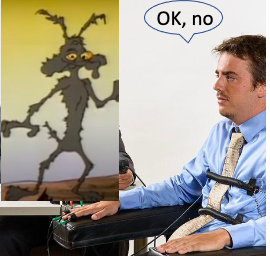
Red Lawhern Ph.D., a healthcare writer and member of the ACSH Board of Advisors, has repeatedly demanded that CDC respond to their many critics who have pointed out that the 2016 US CDC guidelines on opioid prescribing to adults with chronic non-cancer pain are contradicted both by science and the CDC's own statistics. He has received responses but they are just form letters. Here is the latest (I've even added my own translation of the CDC response. No extra charge).
** NOTE - The text in bold is taken directly from the email that Dr. Lawhern received.
CDC: Thank you for your suggestion to CDC-INFO.
JB Translation: Seriously? You really expected this to be read by a human?
CDC: Your comments have been forwarded to the appropriate CDC program for their information.
JB Translation: Your comments will be read, but not so soon. Probably right around the time that the Hubble Telescope spots Wilma Flintstone orbiting Venus while playing mahjong.
CDC: Additionally, here is some information about CDC Guideline for Prescribing Opioids for Chronic Pain that may be helpful to you.
JB Translation: True, if you're running a concentration camp.
CDC: Living with chronic pain can be devastating, and effective pain management is important to getting your life back. It is essential that you and your doctor discuss treatment options, carefully considering all the risks and benefits.
Translation: If you're counting on prescription opioids to get your life back then we have done everything humanly possible to make sure this doesn't happen. Talk to your doctor? Please! If he is/was in pain management there's a pretty good chance he's in the slammer. And if you're fortunate to still have a doctor who's not in the slammer, by all means, speak to him or her. But given pressure from the DEA, you are more likely to walk out of the office with a prescription for Sarin gas than two Vicodins.
CDC's mission is to protect the health and lives of Americans. Improving the way opioids are prescribed can ensure patients have access to safer, more effective chronic pain treatment while reducing the number of people who misuse or overdose from these drugs.
JB Translation: Ha-ha! The joke's on you! Any idiot (perhaps even Andrew Kolodny) knows that there are no safer, more effective alternatives. And the non-idiots also know that at the same time that opioid prescriptions were forced way downward, overdose deaths took off into the stratosphere. CDC knows this. You know this. CDC. Just. Doesn't. Care.
CDC: The Guideline was developed to ensure that primary care doctors work with their patients to consider all safe and effective treatment options for pain management. CDC encourages doctors to continue to use their clinical judgment, base treatment on what they know about their patients, maximize use of safe and effective non-opioid treatments, and consider the use of opioids only if their benefits are likely to outweigh their risks.
JB Translation: Hmm. Is the CDC truthful? Let's conduct an experiment:
1. A CDC empty suit spokesperson is connected to a lie detector and is asked one question. Doesn't really matter what the question is. He answers:

2. The polygraph records biometric data and responds accordingly:

3. Well, that answer seemed to be a bit off. Now what?

Images credits: Medical Daily, YouTube
That's better.
Getting serious for a moment... CDC – please provide a reference to even ONE published randomized controlled trial that demonstrates that cognitive-behavioral therapy or acupuncture when used alone as a substitute for opioids provides a safe and effective alternative to prescription pain relievers. We don’t think you’ll find one.
CDC: The Guideline is not a regulation, but rather a set of recommendations. The recommendations in the Guideline are voluntary, rather than prescriptive standards. The recommendations are intended to support informed clinical decision-making in the context of the provider-patient relationship.
JB Translation: But by an astounding coincidence, the recommendations became restrictive laws in 37 states. And there is an ongoing effort to pass a federal law that is probably even more restrictive. There is no need for decision-making since CDC has already made these decisions and the bureaucrats and politicians reacted just as the authors of the 2016 guidelines knew they would.
CDC: Starting fewer patients on opioid treatment and not increasing to high dosages in the first place will reduce the numbers of patients prescribed high dosages in the long term.
JB Translation: Isn't this a bit like saying: "People who own an accordion are more likely to play the accordion?" And more important, won’t this restriction condemn millions of intractable pain patients to agonizing pain when low-dose therapy proves to be inadequate?
In the meantime, clinicians can maximize use of non-opioid treatments, review with patients the benefits and risks of continuing opioid treatment, provide interested and motivated patients with support to slowly taper opioid dosages..."
JB Translation: "provide interested and motivated patients with support to slowly taper opioid dosages..." somehow turned into involuntary, often rapid, tapering for patients who had neither the interest nor the motivation. This is the biggest lie in the whole damn thing. Tapering for most patients is like “walking off a cliff”
CDC: Your question/comments will be shared with CDC experts working on this important issue.
Translation: Our CDC "experts" don't care whether or not you skydive into the Kilauea Volcano wearing nothing but a G-string. Just don't bother us.
CDC: ***Feedback about your experience with CDC-INFO is important to us and will help us continue to improve.
JB Translation: C'mon! You fell for this? Go look up "nitwit" in the dictionary. Or in the mirror.
CDC: Responses are kept completely confidential.
JB Translation: Finally something true. Of course, there are no responses. Or the CDC doesn’t want the many responses which contradict their fairy tales to be made public.
So, let's give it up for Red, who took considerable time to provide concise, thoughtful comments and data-centric evidence [see http://face-facts.org/lawhern/the-opioid-crisis-in-three-charts/] to CDC, only to be ignored entirely.
Is it any wonder that people don't trust our government?



